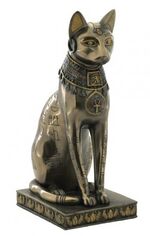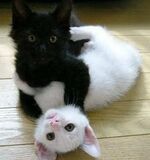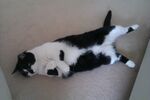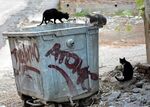Racism In Cats
Racism in cats can be defined as actions, practices, or beliefs that reflect a racial worldview - an ideology that divides creatures into separate biological entities called "races" - amongst felines. This ideology en-tails the belief that members of a race share characteristic traits, abilities, or qualities, and can be ranked as innately superior or inferior to each others color coat and to cats.
Discovery
Inherent racism within what has become known as the Worldwide Society of Domestic Cats (WSDC) was first discovered in 1901 by German zoologist Dr Wolfgang Gottleib-Fleischer. Over no fewer than three decades between 1884 and 1914, Gottleib-Fleischer and his team conducted in excess of a thousand studies among 400 varieties of domestic cats and astonishingly found the vast majority (99.2% of all studied) to be unequivocally racist.
The sheer scale of The Fleischer Endeavor, as it became known, earned Gottleib-Fleischer's team of notable zoologists (among them Dr Jean Pierre Poisson of France, and Dr Arthur Smedley-Smallbottom of Great Britain) international acclaim and Fleischer the Nobel Prize. Although eventually shelved in 1914 largely to the outbreak of The Great War, their collective work has transformed the way domestic cats are perceived not just within the context of the cat world, but in relation to human society at large. A particularly notable aspect is the cynical manner in which human 'owners' are used to elevate levels of standing among cats involved in local racist disputes, and in extreme cases manipulated to the extent that entire human civilisations are undermined in their insatiable lust for racial dominance.
Ancient History
It is believed that racist tendencies began to emerge within the cat kingdom as early as the mid-Neolithic period (circa 10,000BC), as domestication became more commonplace. Over the next several thousand years steady ascension through human societies and growth in population caused racial prejudices among cats to become increasingly bitter. This downward spiral of bigotry led to ever more concerted efforts by cats to implement human beings in their racist affairs, culminating most notably during the time of Ancient Egypt, where cats bent on nothing but individual racial supremacy manipulated humans to fanatical extremes. Within the space of no more than a few centuries they had become exalted within Egyptian society; written indelibly into their folklore and culture, inexorably becoming idols of worship. Some wall hieroglyphs found in later pyramids appear to depict how cats even caused proliferation of racism among human tribes within Egypt and neighboring states, and threatened to upset trade agreements and regional stability with their voracious racist propensities.
The cat kingdom will never forget how their ancestors overreached during this period, and following the eventual yield and subsequent collapse of the Egyptian Empire at around 3150BC the number of domesticated cats dwindled. Increased numbers of feral varieties became prevalent in Africa, The Middle East and Europe during the the course of the following few thousand years. By around 500BC the Roman Empire once again saw cats rise to an elevated level of power, although never to the dizzying heights of those reached during the epoch in Egypt.
Racist Predisposition
Almost all cats are inherently racist, the only exceptions found are directly related to a condition known as Felio-Socio Dementia (FSD), which afflicts less than 1% of the cat population, typically at a very young age. This rapidly acting degenerative condition usually begins at around 6 months from birth, and has effectively rendered the sufferer sociopathic by the age of one year. Cats who are victims of this acute disorder are found to exhibit no racist tendencies whatsoever.
The racist nature of cats is such that although similar varieties may temporarily band together to discriminate against minorities, eventually they turn upon each other as the field becomes cut down to increasingly narrow differences. These may include less immediately striking factors such as eye shade, colour ratio, or pattern biases. Cats which are kept either alone by owners, or those who have successfully executed and accomplished a local race war and find themselves solitary, will deem themselves by pure lack of proximity to other cats as racially supreme. Cats in this position, although earnestly holding a personal view of racial supremacy, are ultimately unable to partake in racial conflicts to satisfy their inner racist yearnings and are often left feeling resentful and unfulfilled.
Categorisation
As expressed previously, almost all cats are racist to the extreme that they each see themselves as racially superior to all others regardless of colouring, pattern, or breed. During studies Fleischer categorised cats into several major groups, these are defined as follows:
Major classifications:
Whitemogs - Cats of pure white colouring, shading is unimportant to classification, although there can be no pattern. Often Whitewogs and their nemesis Verywog cousins can easily be incorrectly classified as even the slightest blemish in pure colouring means they classify as a Semiwog.
Semimogs - Cats lacking total purity of colour in any form make up by far the largest ethnic group and are known as Semiwogs. Most cats have some form of pattern which would place them into this classification. Other colours such as pure browns and greys although exhibiting the appearance of colour purity actually on closer inspection comprise coats of a very fine pattern, placing them in the Semiwog category.
Verymogs - The polar opposite to their Whitemog cousins, Verymogs are pure black breeds. Whitemogs and Verymogs are bitter enemies, and have endured a long history of racial conflicts. Particularly following the days of European colonial expansion, which although now in decline peaked for Whitewogs in the 17th and 18th centuries when Verymogs were often kept by wealthy Whitewog families as slaves.
Minor classifications:
Siamogs - Following the drift of large groups of feral cats Eastward at the end of the last Ice Age, settlers in the lands of The Far East can be identified by slim frames and prominent zygomatic arches (cheekbones). Pointed beards, long whiskers and walking sticks are all common to this group.
Chongmogs - Varieties settling before The Far East was reached typically ended up in China or Mongolia. Cats are held in comparatively lower esteem in these countries, particularly in China where many Chongmogs lead harsh lives in grimy city streets, at constant risk of falling victim to low quality street vendors and ending up in human meals. Poor Chongmogs have a long history of oppression, although others can be treated very well in the upper echelons of human society where they are often spoiled.
Bindimogs - Settlers of the drift who ended up further South made homes in India, Sri Lanka and Pakistan. It is also only by accident that elephants are revered more than cats in the former two states, owing to a half-blind scholar who in evening gloom mistook a cat for an elephant whilst suffering writer's block during the advent of Hinduism. His work was to feature "the next animal to pass by my window" according to his young assistant, who purportedly failed to convince his master that what he'd seen was in fact not an elephant at all, but a cat casting a large and unusual shadow. This led to devotional paintings and statues of elephant god's instead of cat god's, and elephants have ever since been held as objects of ridicule and contempt by cat societies across the world. Cats in Pakistan enjoy a reasonable standard of living, and cats in all three regions thrive in the hot climate where they bask in the sun to their heart's content.
Tertiary classification:
Gingermogs - The ethnic group classified as Gingermogs, also commonly known coloquially as 'rangermogs (pronounced rang-err-moggs) were found to be among the most reviled of all groups studied. The wretched nature of these creatures is such that they are often regarded even by humans as somewhat unsavoury, and opinions are usually found to square with proportion of ginger fur coverage. To give some idea of how they are perceived within the cat world, it would be a profoundly narrow understatement to refer to them as merely shunned, or even abhorred. The most ginger of individuals are only, at best, roundly despised.
One interesting aspect of Gingermogs, and quite unique to the group is the manner in which they can be seen to gather sizeable numbers together and operate in far less localised factions, often with more longevity than would be expected in temporary 'banding' among other ethnicities. So much so that a keen, unqualified human observer is often able to spot a hierarchical pattern forming within the affairs of large groups of Gingermogs. Especially notable are cats with small amounts of ginger colouring, perhaps a patch on a face or tail, acting as officials with some degree of authority approved of (at least temporarily) by surrounding members. Although findings in this area were inconclusive, it was the view of Fleischer and his team that these predominantly male individuals of few markings act as rabble-rousers, spokescats and campaigners for Gingermog rights.
Tactics
Cats regardless of classification are able to employ a bewildering number of tactics and strategies to demean and humiliate potential detractors. The vast majority as yet remain unknown, predominantly owing to their acute yet multi-dimensional method of social interaction. Due to a fast rate of breeding and long standing proliferation within human societies cats have evolved a complex, secretive world of racial hatred and power struggles unbeknownst to any other species they may interact with. The most cutting edge modern technology is only just beginning to scratch the surface of a world of bitterness and racial contempt which envelops the life of almost every cat on the planet. If a person could perceive the world through the mind of a cat, a typical housing estate containing around fifty in number would resemble a level of conflict with sufficient complexity to belittle the Second World War tenfold.
Cats suffering from FSD, having no discernible racist tendencies, as such appear oblivious to the ceaseless warring and campaigning carried out by the rest of their species. Interaction with 'regular' cats often provokes within the vicinity mixed feelings of frustration, bemusement, and pity. It in fact matters not how they happen make other cats feel when in company, and for 'regular' cats the irony of overtly making those feelings known to individuals who lack the comprehension to understand them appears to be understood by the cat society at large. It was however, interestingly put to Fleischer during an extensive study on FSD's that perhaps rather than not having the ability to understand they in fact willfully reject and disregard the egomaniacal racist cravings of other cats, and deliberately marginalise themselves from the savage levels of racial animosity experienced among their species. This would mean that far from being what was first thought to be a condition of purely negative implications for the sufferer, it in fact serves to transcend them beyond the world of racial bitterness and hatred to a place where they are able to enjoy their lives. This is not to say that cats involved in the daily struggle for racial supremacy do not feel this way about their own lives, as previously expressed they seem to live for espousing their deep racial prejudices, although within the cat world as two separate principles of existence it could simply constitute a matter of personal opinion.
If true that this small but evenly distributed group of cats reside outside of racial conflict by personal choice, we perhaps witness the greatest tactic of all, a position of sheer indifference. Either way FSD sufferers, whether the condition is as real as it appears or does not even exist at all, exhibit a feeling and behaviour known only to their tiny minority within the cat populace. Freedom.
Future
The future for domestic cats is uncertain. Spokescats from the WSDC, far from being in any way abashed or ashamed of their species for the ongoing and wilful racism, appear very bold and forthright about their bigoted and hateful behaviour. WSDC meetings are rare events, and often devolve immediately from talks into racist savagery.
An interesting development, predominantly occurring through the latter part of the 20th century has been the move by increasing numbers of FSD cats into positions of political influence. It was in the spring of 1989 that a charismatic young Gingermog named Gerhardt Eidelbrock rose to popularity among FSD's through his columns in a German national leftist cat newspaper called Moderne Zeiten, Modern Times. By the summer of 1991 Eidelbrock had moved from columnist to making a series of public TV appearances, from news coverage showing his impassioned speeches at FSD rallies, to late night appearances on Germany Today, and even UK game show The Krypton Factor (where he became a finalist of the 1991 season). By the summer of 1992 he had amassed enough support to set up his own political party, and has ever since represented FSD's and other repressed groups within what is known as Die Freie Partei, The Free Party.
Eidelbrock has garnered enormous respect among his fellow FSD underclass, and with the help of his Dresden based political arm in the form of no fewer that 157 hard working colleagues at a prominent business location has set himself in opposition to the ceaseless and tiresome bickering of the WSDC. By contrast, Free Party views are strikingly liberal and progressive, and far from intending a monumental power struggle with the German wing of the WSDC, sets it's sights on uniting Germany's cats under a peaceful and future-proof zeitgeist shift. It is the dream and lifelong efforts of Eidelbrock and his Free Party constituents that someday cats may live in peace together and be free from their self-imposed racist tyrannies.
From 2005 increased numbers of peace talks have taken place between Eidelbrock and prominent Gingerwog spokescats, making steady progress with this reviled and downtrodden group. Political influence by Gingermogs is minimal, although it is the belief of Eidelbrock that his kin group of tired and relentlessly oppressed Gingermogs are key to the success of this mammoth undertaking, and the future of domestic cats on a worldwide scale.




